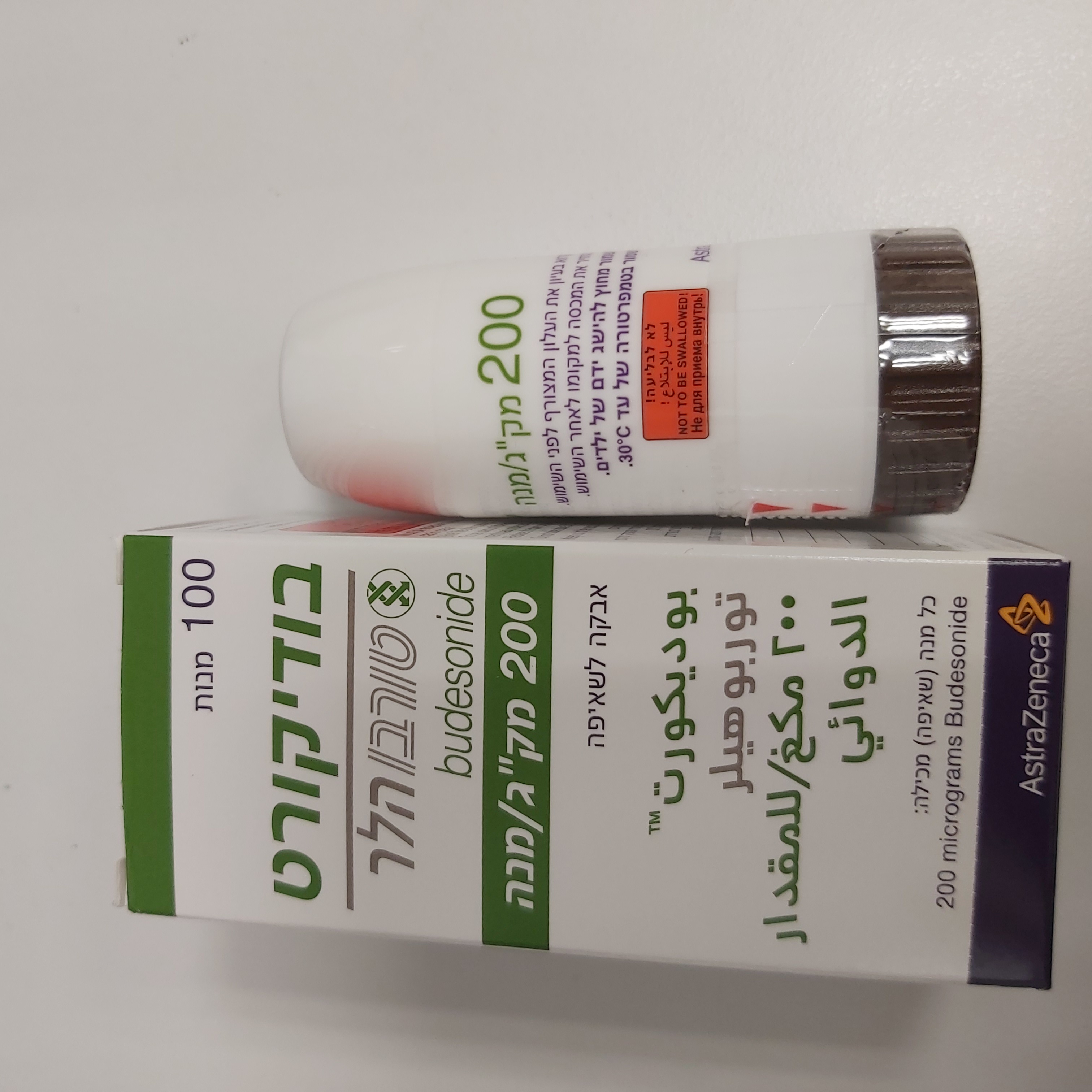Quest for the right Drug

בודיקורט טורבוהלר 200 מק"ג/מנה BUDICORT TURBUHALER 200 MCG/DOSE (BUDESONIDE)
תרופה במרשם
תרופה בסל
נרקוטיקה
ציטוטוקסיקה
צורת מתן:
שאיפה : INHALATION
צורת מינון:
אבקה לשאיפה : POWDER FOR INHALATION
עלון לרופא
מינוניםPosology התוויות
Indications תופעות לוואי
Adverse reactions התוויות נגד
Contraindications אינטראקציות
Interactions מינון יתר
Overdose הריון/הנקה
Pregnancy & Lactation אוכלוסיות מיוחדות
Special populations תכונות פרמקולוגיות
Pharmacological properties מידע רוקחי
Pharmaceutical particulars אזהרת שימוש
Special Warning עלון לרופא
Physicians Leaflet
Pharmacological properties : תכונות פרמקולוגיות
Pharmacodynamic Properties
5.1 Pharmacodynamic properties Budesonide is a glucocorticosteroid which possesses a high local anti-inflammatory action, with a lower incidence and severity of adverse effects than those seen with oral corticosteroids. Pharmacotherapeutic group: Other drugs for obstructive airway diseases, inhalants, glucocorticoids. ATC Code: R03B A02. Topical anti-inflammatory effect The exact mechanism of action of glucocorticosteroids in the treatment of asthma is not fully understood. Antiinflammatory actions, such as inhibition of inflammatory mediator release and inhibition of cytokine-mediated immune response are probably important. A clinical study in asthmatics comparing inhaled and oral budesonide at doses calculated to achieve similar systemic bioavailability demonstrated statistically significant evidence of efficacy with inhaled but not oral budesonide compared with placebo. Thus, the therapeutic effect of conventional doses of inhaled budesonide may be largely explained by its direct action on the respiratory tract. In a provocation study pre-treatment with budesonide for four weeks has shown decreased bronchial constriction in immediate as well as late asthmatic reactions. Onset of effect After a single dose of orally inhaled budesonide, delivered via dry powder inhaler, improvement of the lung function is achieved within a few hours. After therapeutic use of orally inhaled budesonide delivered via dry powder inhaler, improvement in lung function has been shown to occur within 2 days of initiation of treatment, although maximum benefit may not be achieved for up to 4 weeks. Airway reactivity Budesonide has also been shown to decrease airway reactivity to histamine and methacholine in hyper-reactive patients. Exercise-induced asthma Therapy with inhaled budesonide has effectively been used for prevention of exercise-induced asthma. Growth In short term studies a small and generally transient reduction in growth has been observed, which usually occurs within the first year of treatment. Long-term observational studies suggest that children and adolescents treated with inhaled corticosteroids on average achieve their adult target height. However, in one study children who had been treated with high dose inhaled budesonide (400 micrograms daily) for up to 6 years without titration to the lowest effective dose were found on average to be 1.2 cm shorter as adults than those treated with placebo over the same period. See section 4.4 about titration to the lowest effective dose and about monitoring the growth in children. Paediatric Population Slit lamp examinations were performed in 157 children (5-16 years old), treated with an average daily dose of 504 μg for 3-6 years. Findings were compared with 111 age-matched asthmatic children. Inhaled budesonide was not associated with an increased occurrence of posterior subcapsular cataract. Influence on plasma cortisol concentration Studies in healthy volunteers with Budicort Turbohaler have shown dose-related effects on plasma and urinary cortisol. At recommended doses, Budicort Turbohaler, causes less effect on the adrenal function than prednisolone 10mg, as shown by ACTH tests.
Pharmacokinetic Properties
5.2 Pharmacokinetic properties Absorption Following oral inhalation via Budicort Turbohaler, peak plasma concentrations of budesonide (4.0 nmol/L after a dose of 800 μg) occur within 30 minutes. Maximum plasma concentration and area under the plasma concentration time profile increase linearly with dose, but are slightly (20-30%) higher following repeated doses (3 weeks treatment) than after a single dose. Lung deposition in healthy subjects was estimated to 34% ±10% of the metered dose (arithmetic mean ± SD), while 22% was retained in the mouthpiece and the rest (approximately 45% of the metered dose) was swallowed.The maximal plasma concentration after inhalation of 1 milligram budesonide is about 3.5 nmol/L and is reached after about 20 minutes. Distribution Budesonide has a volume of distribution of approximately 3 L/kg. Plasma protein binding averages 85-90%. Biotransformation Budesonide undergoes an extensive degree (approximately 90%) of biotransformation on first passage through the liver to metabolites of low glucocorticosteroid activity. The glucocorticosteroid activity of the major metabolites, 6βhydroxybudesonide and 16α-hydroxyprednisolone, is less than 1% of that of budesonide. The metabolism of budesonide is primarily mediated by CYP3A, a subfamily of cytochrome p450. Excretion The metabolites of budesonide are excreted as such or in conjugated form mainly via the kidneys. No unchanged budesonide has been detected in the urine. Budesonide has high systemic clearance (approximately 1.2 L/min) in healthy adults, and the terminal half-life of budesonide after iv dosing averages 2-3 hours. Linearity The kinetics of budesonide are dose-proportional at clinically relevant doses. In a study, 100 mg ketoconazole taken twice daily, increased plasma levels of concomitantly administered oral budesonide (single dose of 10 mg) on average, by 7.8-fold. Information about this interaction is lacking for inhaled budesonide, but marked increases in plasma levels could be expected. Paediatric safety data Budesonide has a systemic clearance of approximately 0.5 L/min in 4-6 years old asthmatic children. Per kg body weight children have a clearance which is approximately 50% greater than in adults. The terminal half-life of budesonide after inhalation is approximately 2.3 hours in asthmatic children. This is about the same as in healthy adults. In asthmatic children treated with Budicort Turbohaler (800 μg single dose), plasma concentration reached Cmax (4.85 nmol/L) at 13.8 minutes after inhalation, and then decreased rapidly; AUC was 10.3 nmolꞏh/L. The value for AUC is generally comparable to that observed in adults at the same dose, however, the Cmax value tends to be higher in children. Lung deposition in children (31% of the nominal dose) is similar to that measured in healthy adults (34% of nominal dose).

שימוש לפי פנקס קופ''ח כללית 1994
Bronchial asthma. יירשם ע"י רופא מומחה למחלות ריאה ואלרגולוג
תאריך הכללה מקורי בסל
01/01/1995
הגבלות
תרופה מוגבלת לרישום ע'י רופא מומחה או הגבלה אחרת
מידע נוסף
